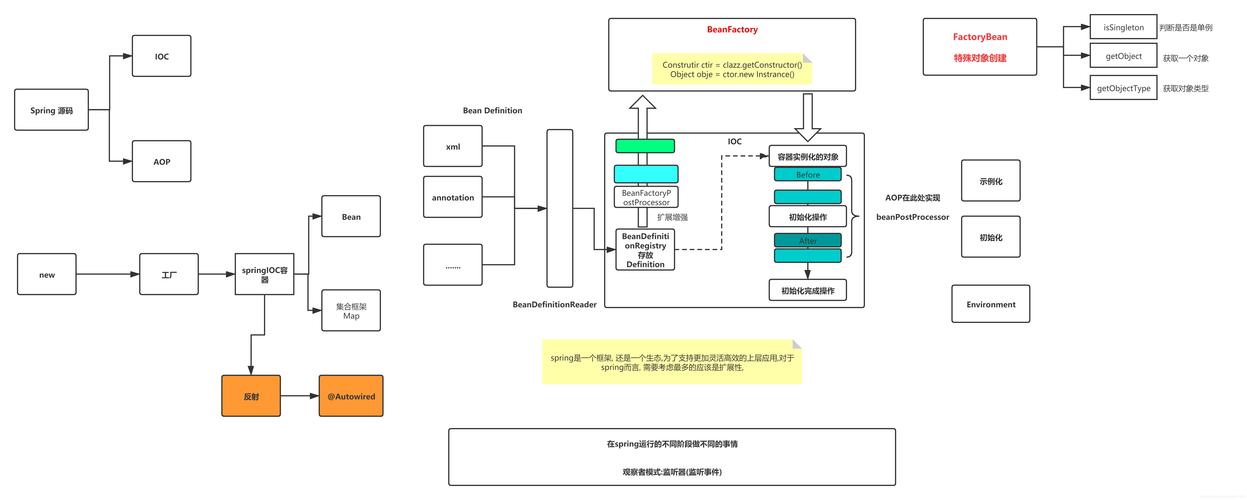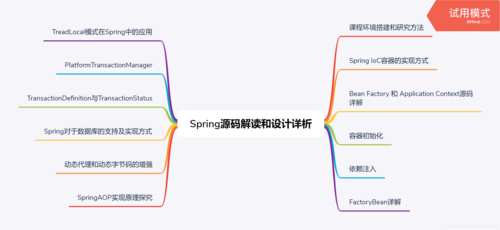一、组合模式简介
组合模式的核心思想是将对象组合成树形结构,以表示“部分-整体”的层次结构。组合模式使得用户对单个对象和组合对象的使用具有一致性。
组合模式的 UML 类图: Component + operation() + add(Component) + remove(Component) + getChild(int) | | +------------------+ | |Leaf Composite+ operation() + operation() + add(Component) + remove(Component) + getChild(int)二、Spring BeanFactory 简介
Spring Framework 中的 BeanFactory 是一个负责管理 Bean 的工厂类。它提供了 IoC(Inversion of Control)容器的基本实现,用于实例化、配置和管理 Bean。
三、组合模式在 BeanFactory 中的体现在 Spring 中,BeanFactory 及其子类(如 ApplicationContext)使用组合模式来管理 Bean 的定义和依赖关系。BeanFactory 作为 Component,具体的 Bean 定义作为 Leaf,组合 Bean 定义作为 Composite。

以下是一个简单的示例代码,展示了如何在 Spring 中使用组合模式管理 Bean:
示例代码:import org.springframework.context.ApplicationContext;import org.springframework.context.support.ClassPathXmlApplicationContext;// 定义一个简单的服务接口interface Service { void execute();}// 定义一个具体的服务实现类class SimpleService implements Service { @Override public void execute() { System.out.println("Executing Simple Service..."); }}// 定义一个组合服务实现类class CompositeService implements Service { private final List<Service> services = new ArrayList<>(); public void addService(Service service) { services.add(service); } @Override public void execute() { for (Service service : services) { service.execute(); } }}// Spring 配置文件 (beans.xml)/<beans xmlns="http://www.springframework.org/schema/beans" xmlns:xsi="http://www.w3.org/2001/XMLSchema-instance" xsi:schemaLocation="http://www.springframework.org/schema/beans http://www.springframework.org/schema/beans/spring-beans.xsd"> <bean id="simpleService" class="SimpleService" /> <bean id="compositeService" class="CompositeService"> <property name="services"> <list> <ref bean="simpleService"/> </list> </property> </bean></beans>/public class MainApp { public static void main(String[] args) { ApplicationContext context = new ClassPathXmlApplicationContext("beans.xml"); Service compositeService = (Service) context.getBean("compositeService"); compositeService.execute(); }}五、源码解析
在 Spring 框架中,组合模式主要体现在 BeanFactory 和 ApplicationContext 的实现中。以下是部分源码解析:

public interface BeanFactory { Object getBean(String name) throws BeansException; <T> T getBean(String name, Class<T> requiredType) throws BeansException; <T> T getBean(Class<T> requiredType) throws BeansException; Object getBean(String name, Object... args) throws BeansException; }DefaultListableBeanFactory 类: DefaultListableBeanFactory 是 BeanFactory 的具体实现类,负责管理 Bean 的定义和实例化。
public class DefaultListableBeanFactory extends AbstractAutowireCapableBeanFactory implements ConfigurableListableBeanFactory, BeanDefinitionRegistry { // 管理 Bean 定义的 Map private final Map<String, BeanDefinition> beanDefinitionMap = new ConcurrentHashMap<>(256); @Override public Object getBean(String name) throws BeansException { return doGetBean(name, null, null, false); } // 其他方法实现... }组合模式的体现: DefaultListableBeanFactory 通过 beanDefinitionMap 管理所有的 Bean 定义,类似于组合模式中的 Composite。 每个具体的 Bean 定义(如 SimpleService)类似于组合模式中的 Leaf。 组合 Bean 定义(如 CompositeService)可以包含其他 Bean 定义,体现了组合模式的“部分-整体”关系。六、总结
本文详细解析了组合模式在 Spring BeanFactory 中的应用,通过示例代码和源码解析,帮助你深入理解这一设计模式。在实际项目中,合理使用组合模式可以提高代码的可维护性和扩展性。
互动与讨论如果你在使用 Spring 和设计模式的过程中遇到任何问题,或者有更好的实践经验,欢迎在评论区分享你的见解和讨论。你的参与将帮助更多的开发者解决类似问题。




